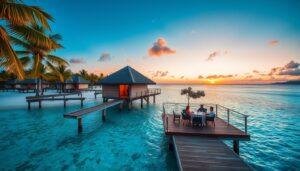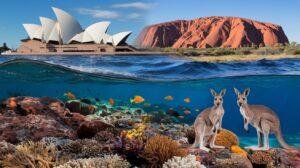Have you ever dreamed of standing under a sky painted with shimmering green and purple hues? The Northern Lights, or Aurora Borealis, are a breathtaking natural wonder. They have captivated travelers from around the world. From Iceland’s remote reaches to Finnish Lapland’s heart, these mesmerizing displays are a must-see for aurora hunters and nature lovers.
This guide will take you on a journey to the best places to see the Northern Lights. You’ll learn about the science behind this natural wonder and get practical tips for your adventure. Whether you want Norway’s remote wilderness or Finland’s cozy glass igloos, the wonders of the Aurora Borealis await.
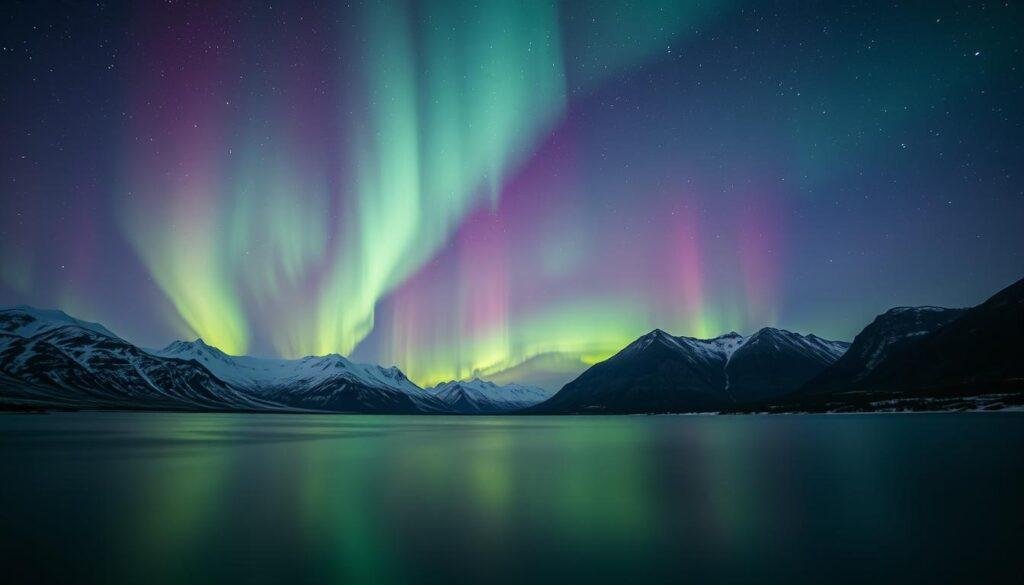
Key Takeaways
- Discover the top destinations for Northern Lights viewing around the world
- Understand the scientific explanation behind the Aurora Borealis phenomenon
- Explore the best times to visit and the factors that influence viewing success
- Learn essential photography tips to capture the stunning colors of the Northern Lights
- Gain practical guidance for planning an unforgettable Northern Lights adventure
Understanding the Northern Lights Phenomenon
The aurora borealis, or northern lights, is a stunning sight that draws people from all over. To truly enjoy this wonder, knowing how it’s made is key.
Scientific Explanation of Aurora Borealis
The northern lights happen when the Earth’s magnetic field meets solar wind. Solar wind is charged particles from the Sun. These particles are pulled towards the Earth’s poles by the magnetic field.
When they hit the Earth’s atmosphere, they light up the sky with colors. This creates the beautiful aurora borealis.
What Causes the Different Colors
- The colors of the aurora borealis depend on the gases in the atmosphere and the energy of the particles.
- Oxygen makes green and red, while nitrogen makes blue and purple.
- The height of the collisions also affects the colors, with higher altitudes showing brighter lights.
Peak Seasons and Solar Activity
The best time to see northern lights is in the fall and spring. This is when the Earth’s magnetic field is most active. The aurora borealis gets more intense with the 11-year solar cycle.
Learning about the aurora borealis makes it even more special. It helps travelers know when and where to see this amazing sight.
Top Countries for Northern Lights Viewing
The world has many places to see the northern lights. Iceland, Norway, and Finnish Lapland are among the best. These places offer unforgettable views of the aurora.
Iceland is famous for its northern lights. You can see them in Reykjavik, Thingvellir National Park, or the countryside. Norway’s northern coast is also great, with towns like Tromsø and Svalbard.
Finland’s Lapland is a winter wonderland. You can see the northern lights from glass igloos or traditional Sami culture. Rovaniemi, Santa Claus’s hometown, is perfect for aurora hunting.
Canada’s northern territories and Alaska in the United States are also top spots. They offer rugged landscapes and remote wilderness for viewing the northern lights.
Choosing the right place for northern lights is key. Understanding the aurora and planning well are important. With luck, you’ll see nature’s most amazing light show.
Iceland: Prime Aurora Viewing Destinations
Iceland is a top spot for seeing the amazing aurora borealis. You can find great places to watch it from Reykjavik to Thingvellir National Park. It’s a chance to see the aurora borealis in Iceland up close.
Reykjavik and Surrounding Areas
Reykjavik, Iceland’s capital, is a great place to start your northern lights vacation packages. It’s close to the northern lights and has little light pollution. Places like Seltjarnarnes peninsula and Grotta Nature Reserve also offer great views.
Thingvellir National Park Viewpoints
Thingvellir National Park is in southwestern Iceland. It’s a UNESCO World Heritage site and perfect for aurora borealis in Iceland. The park’s unique landscapes, like the Almannagja fault, make it a stunning place to see the northern lights.
Best Hotels for Northern Lights in Iceland
- Hotel Rangá: This luxury resort in southern Iceland has amazing views and wake-up calls for the northern lights.
- ION Adventure Hotel: In the Thingvellir area, this eco-friendly hotel has great views of the aurora and hot springs.
- Deplar Farm: In the Troll Peninsula, this exclusive retreat has perfect views of the northern lights and luxury facilities.
Iceland is perfect for seeing the northern lights. You can explore Reykjavik, visit Thingvellir National Park, or stay in special hotels. It’s a trip you’ll never forget.

Norway’s Aurora Belt Experience
Norway is a top spot for seeing the northern lights norway. It’s called the “Aurora Belt.” This place is magical for those who love the aurora and nature.
Tromsø is known as the “Gateway to the Arctic.” It’s a great place to see the arctic circle northern lights. Tromsø is on an island with mountains and fjords, making it perfect for watching the northern lights.
- Go on a fjord cruise and see the northern lights norway light up the sky.
- Try dog sledding under the arctic circle northern lights for an exciting experience.
- Check out the Polaria aquarium in Tromsø to learn about the northern lights norway.
The town of Alta is also great for arctic circle northern lights viewing. It’s called the “Northern Lights Capital of Norway.” Alta has special experiences that let you enjoy the northern lights norway fully.
“The northern lights in Norway are an absolute must-see. The way they dance and change colors is truly breathtaking.” – Jørgen Hauer, professional photographer
The Lofoten Islands offer a unique northern lights norway experience. The islands have beautiful peaks, fjords, and villages. They make a perfect setting for the northern lights.

Whether you want adventure or peace, Norway’s arctic circle northern lights will amaze you.
Wonder of Northern Lights in Finnish Lapland
Finnish Lapland is in the heart of the Nordic region. It offers a magical experience for those wanting to see the northern lights. You can stay in luxury glass igloos or go on exciting aurora hunting trips. This place is perfect for diving into the finland northern lights resorts and northern lights tours and tips.
Glass Igloos and Resort Experiences
In Finnish Lapland, you’ll find many glass igloos. They let you watch the northern lights from your own room. These resorts are special, offering a warm and cozy way to see the aurora borealis.
Rovaniemi Aurora Hunting
Rovaniemi is known as the “Official Hometown of Santa Claus.” It’s a top spot for northern lights tours and tips. You can go on exciting aurora hunting trips. Local experts will help you find the best spots to see the northern lights.
Traditional Sami Culture and Lights
The northern lights are important to the Sami people in Finnish Lapland. You can learn about their traditions and beliefs. This adds a special touch to your finland northern lights resorts and northern lights tours and tips experience.
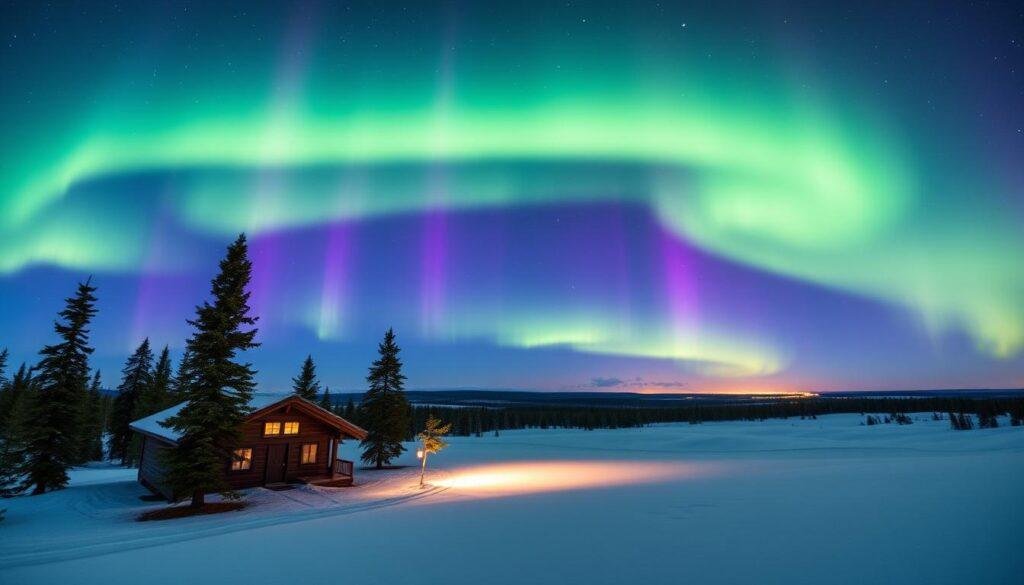
“The northern lights in Finnish Lapland are truly a sight to behold, a celestial dance that captivates the senses and ignites the imagination.”
Alaska’s Premium Viewing Locations
Alaska, the northernmost U.S. state, is famous for its stunning Northern Lights, or aurora borealis. It’s a top spot for seeing the Northern Lights in winter. Alaska has many amazing places to watch the aurora borealis.
Fairbanks is a top choice, right in the “aurora oval.” It has some of the best Northern Lights shows, with lights on up to 240 nights a year. Chena Hot Springs Resort nearby offers a special experience. You can see the lights while enjoying the warm geothermal pools.
Anchorage, further south, also offers great views of the Northern Lights. Denali National Park, with its famous Denali peak, is a beautiful place to see the lights. You can take guided tours or watch from your lodge.
| Location | Best Viewing Season | Unique Experiences |
|---|---|---|
| Fairbanks | September to April | Chena Hot Springs Resort |
| Anchorage | September to April | Denali National Park |
Exploring the Northern Lights in Fairbanks, Anchorage, or Denali is unforgettable. Alaska’s clear skies and crisp air make it perfect for seeing the aurora borealis. With the right timing, you’ll be amazed by the lights’ dance.
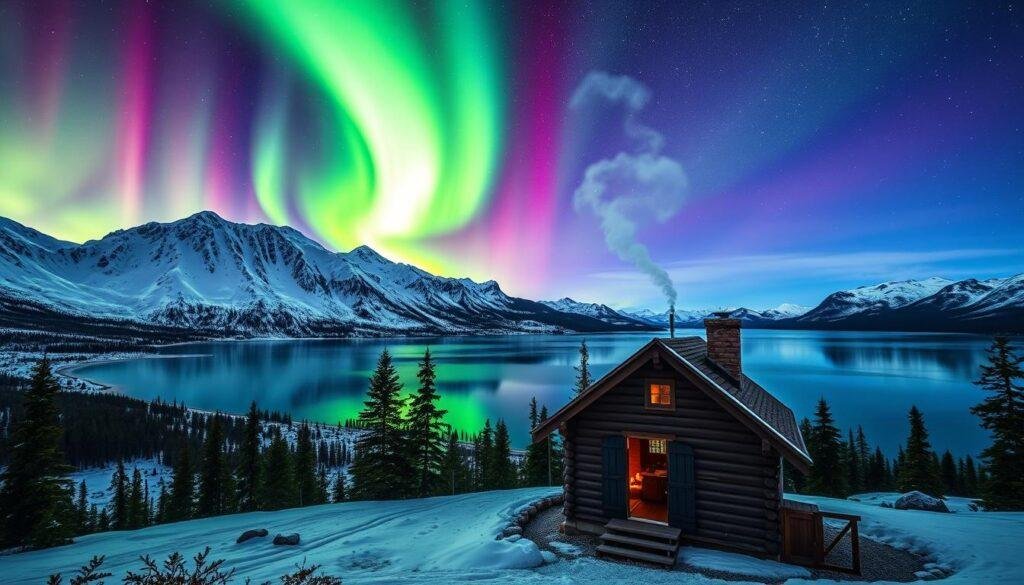
Essential Photography Tips for Aurora Capture
Capturing the ethereal beauty of the northern lights is thrilling and rewarding. Whether you’re a pro or a hobbyist, mastering northern lights photography needs both technical skills and creativity. Here, we’ll share key tips and techniques for stunning northern lights photography results.
Camera Settings and Equipment
To capture the vibrant northern lights, you need the right camera and settings. Use a DSLR or mirrorless camera with manual controls. This lets you adjust exposure, aperture, and shutter speed.
A wide-angle lens with a fast aperture (f/2.8 or faster) is best for the night sky and aurora. Also, bring a sturdy tripod for sharp, blur-free images.
Time-Lapse Techniques
Time-lapse videos of the northern lights are captivating. Set your camera to take long-exposure shots (10-30 seconds) at regular intervals. Use a remote shutter release or intervalometer for automation.
Make sure to use a sturdy tripod to keep the frame stable throughout.
Mobile Photography Guidelines
While cameras offer the best results, smartphones have improved in low-light shots. If using a smartphone, use a tripod or stabilizer to reduce camera shake. Look for apps with manual controls for longer exposures.
Experiment and be patient to capture stunning northern lights shots with your smartphone.
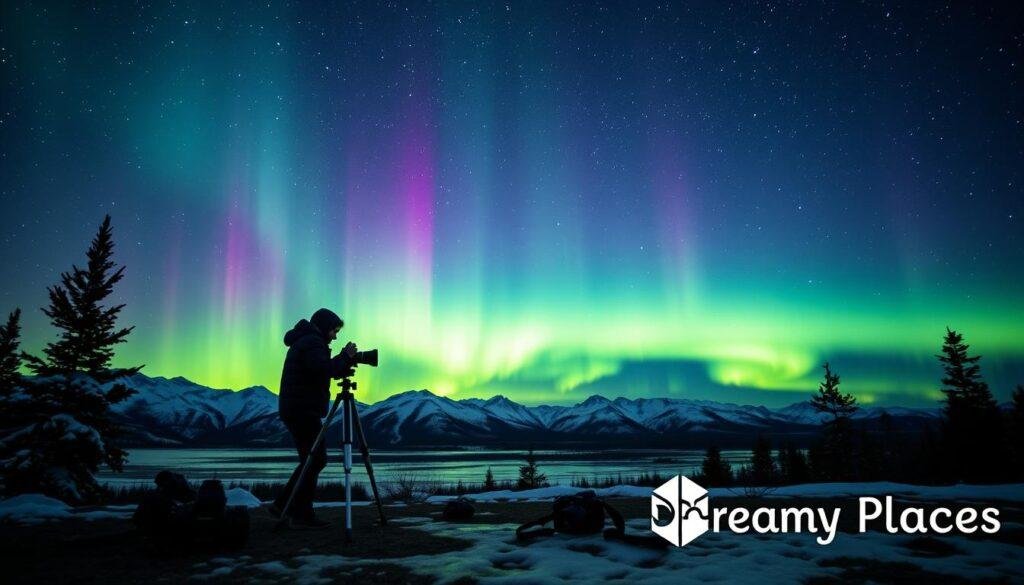
Capturing the northern lights is an art that takes practice and patience. By mastering technical skills and embracing the unpredictable nature of this phenomenon, you’ll create breathtaking northern lights photography that will amaze your audience.
Planning Your Northern Lights Trip
Seeing the northern lights is a dream for many. Planning your aurora borealis trip needs careful thought. From booking flights to picking the right place to stay, these tips will help you plan the perfect northern lights vacation packages.
Choosing Your Destination
Choosing the right place is key for a great northern lights trip. Countries like Iceland, Norway, Finland, and Alaska are known for great views. Look into the best times and places to see the lights in each spot.
Accommodations and Guided Tours
For a great aurora borealis travel guide, pick places with great views. You can stay in cozy cabins or glass-domed igloos. Guided tours can also help, showing you the best spots and explaining the science behind the lights.
Packing and Preparation
The Arctic weather is cold, so pack right. Wear warm, waterproof clothes and sturdy boots. Bring hats, gloves, and hand warmers too. And don’t forget your camera and tripod to capture the northern lights.
With good planning and these tips, you’re set for an amazing northern lights vacation packages trip. Enjoy the aurora borealis and make memories in these stunning places.
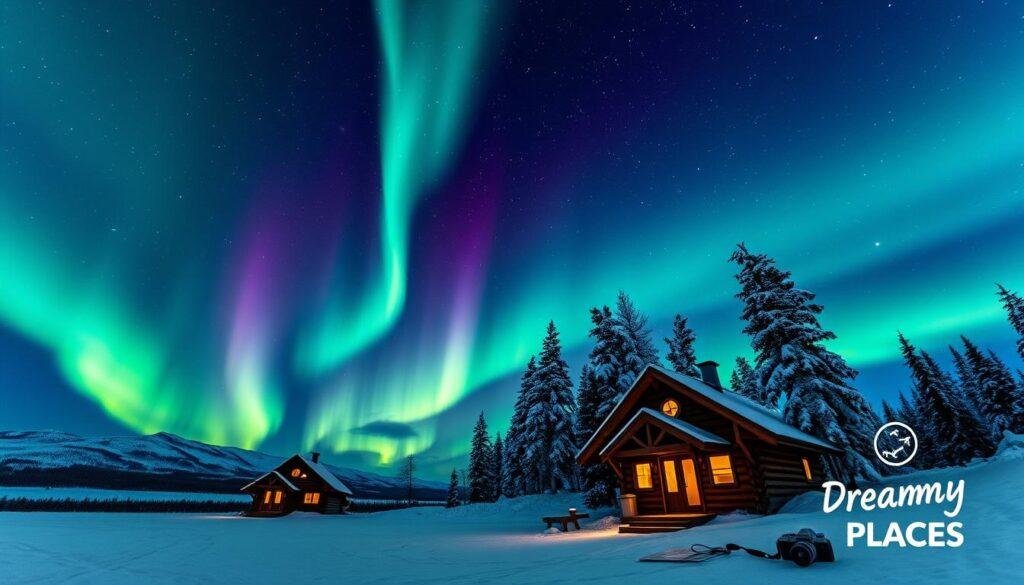
| Destination | Peak Season | Recommended Accommodations |
|---|---|---|
| Iceland | September to April | Reykjavik hotels, Icelandair Hotel Reykjavik Natura |
| Norway | November to March | Tromsø hotels, Levi Igloos |
| Finnish Lapland | August to April | Rovaniemi resorts, Kakslauttanen Arctic Resort |
| Alaska | September to April | Fairbanks hotels, Chena Hot Springs Resort |
Weather Conditions and Viewing Success
Seeing the northern lights is amazing, but the weather matters a lot. Knowing about aurora forecasts and the best weather can help you see this natural wonder. Booking flexible travel dates also increases your chances.
Understanding Aurora Forecasts
It’s important to watch aurora forecasts to plan your trip. These forecasts tell you when and where to see the best time to see northern lights. Learning about these forecasts helps you pick the best spots for viewing.
Best Weather Conditions
Good weather is key for a great northern lights view. You want clear skies, low clouds, and little light pollution. Try to go when it’s dry and the air is stable for the best view.
Booking Flexible Dates
Booking flexible dates is smart for seeing the northern lights. The aurora can be unpredictable, and the weather can change fast. Being flexible lets you adapt and see the best time to see northern lights more easily.
Understanding the northern lights and being ready for changing weather makes your trip unforgettable. Knowing about aurora forecasts, the best weather, and being flexible will help you see the northern lights viewing locations at their best.
Conclusion
The Northern Lights have amazed people for centuries. This guide has shown the best spots to see the Aurora Borealis. Places like Iceland, Norway, and Finnish Lapland are top choices.
It’s not just about the beauty; there’s science behind the Northern Lights too. We’ve learned how solar activity and the atmosphere create these stunning displays. With tips on photography and planning, you’re ready for your own aurora adventure.
Whether you’re a seasoned traveler or new to exploring, the Northern Lights are a must-see. Start planning your trip to see this natural wonder. This guide will help you have an unforgettable experience.
FAQ
What are the best places to see the Northern Lights?
Top spots for the Northern Lights include Iceland, Norway, Finland, Sweden, Canada, and Alaska. Each place offers a unique view of the Aurora Borealis and the chance to explore the Arctic.
When is the best time to see the Northern Lights?
You can see the Northern Lights from September to March. This time has longer nights and more solar activity, perfect for viewing.
How do I increase my chances of seeing the Northern Lights?
To see the Northern Lights, pick a place with clear skies and check aurora forecasts. Book flexible travel dates and choose a spot with little light pollution for better views.
What camera settings and equipment are best for photographing the Northern Lights?
For Northern Lights photos, use a DSLR or mirrorless camera with manual controls. A wide-angle lens, tripod, and remote shutter release are also key. Settings should include long exposure, wide aperture, and low ISO. Time-lapse can also capture stunning images.
How do I plan a Northern Lights vacation?
Plan your Northern Lights trip by researching and booking in prime spots. Arrange transport and consider guided tours. Pack warm clothes and book flexible dates for better chances of seeing the lights.
What is the science behind the Northern Lights?
The Northern Lights are caused by the Earth’s magnetic field and solar wind particles. These particles hit the atmosphere, making it glow with colors in the night sky.

